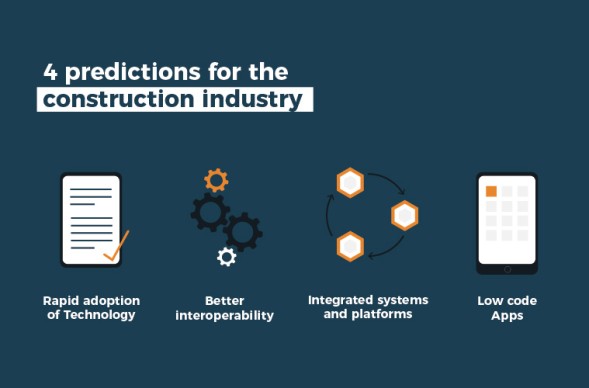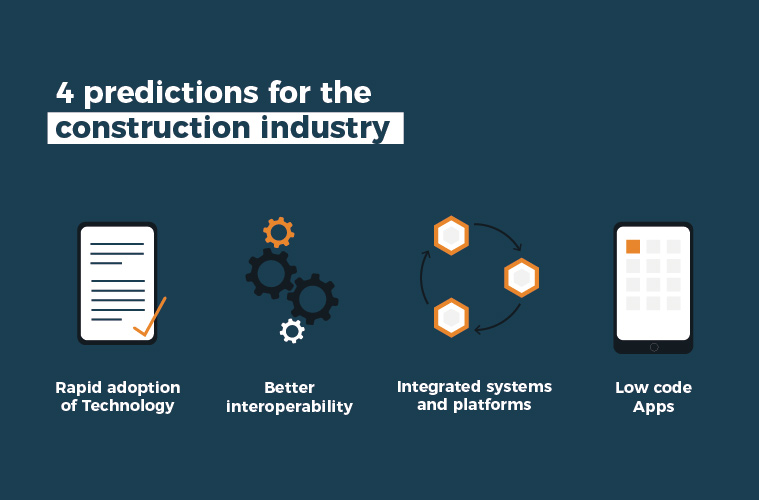Author
Zigurat Global Institute of Technology
Blog / BIM & Construction Management
Categories


 One – We will see rapid adoption of technology. There is no doubt that the global COVID-19 pandemic has artificially accelerated technology investment and adoption especially around how we communicate and collaborate. This will continue to be the case as the construction industry settles into what is being called the ‘new normal’. Undoubtably the workplace will start to look very different as more people begin to work remotely and in more outdoor areas.
Two – Better interoperability. We will begin to see better interoperability and better use of open standards that will allow us to transfer data and use it for different things. Currently construction technology companies are largely split between traditional large software venders or small start-ups (broadly speaking). Over the last few years many larger construction technology providers are getting larger via mergers and acquisitions – often incorporating a new start-up before the start-up has had any opportunity to add any competition to the marketplace or innovation into the market place. Lots of investment are being made into the big technology companies but the industry has yet to witness many breakout disruptors emerge. Perhaps this is due to the industries reliance on a small number of companies for our digital tools which has resulted in different software that do not communicate well with one another. With the development of Open Standards, we will have the ability to better transfer information between venders without losing data and wasting time.
Three – Move towards singular integrated systems and platforms. Organisations are starting to procure their technology stacks and constellations of technologies as opposed to one-off software solutions. This has perhaps been fuelled and supported by vendors moving to cloud based software (Software as a service). I see the construction industry continue its transformation from one that is highly complex and fragmented, and project based to one that is more standardize, consolidated and integrated. Traditional construction technologies are usually aimed at a particular stage in the project life cycle and are point solutions rather than an integrated one. Essentially, we have lots of different solutions to solve many different problems and we do not have an over arching platform or technologies that really cut across all the different stages in a project.
We will see this idea of buying into ecosystems (Apple being a simple analogy – the iphone, ipad, icloud, iwatch, apple TV and apple music all working together). These platforms are attractive because of their ability to increase customer ‘stickiness’ – in that consumers get locked into an ecosystem of solutions. The more features and interfaces offered the higher the likelihood that a platform will become a critical part of an organisations day to day operation. For larger technology companies this means operating at scale to remain competitive, while for small technology companies (offering point solutions) will need to consider how they integrate with these broader ecosystems.
Four – Low code Apps. We will see more ‘Low code applications’ develop that do not require much in the way or previous or in-depth coding experience in order build or developed processes. We will see project and construction managers begin to interact with mobile applications that then feed into desktop applications.
Author: Stefan Mordue, director of the Master's in Global BIM Management of Zigurat
One – We will see rapid adoption of technology. There is no doubt that the global COVID-19 pandemic has artificially accelerated technology investment and adoption especially around how we communicate and collaborate. This will continue to be the case as the construction industry settles into what is being called the ‘new normal’. Undoubtably the workplace will start to look very different as more people begin to work remotely and in more outdoor areas.
Two – Better interoperability. We will begin to see better interoperability and better use of open standards that will allow us to transfer data and use it for different things. Currently construction technology companies are largely split between traditional large software venders or small start-ups (broadly speaking). Over the last few years many larger construction technology providers are getting larger via mergers and acquisitions – often incorporating a new start-up before the start-up has had any opportunity to add any competition to the marketplace or innovation into the market place. Lots of investment are being made into the big technology companies but the industry has yet to witness many breakout disruptors emerge. Perhaps this is due to the industries reliance on a small number of companies for our digital tools which has resulted in different software that do not communicate well with one another. With the development of Open Standards, we will have the ability to better transfer information between venders without losing data and wasting time.
Three – Move towards singular integrated systems and platforms. Organisations are starting to procure their technology stacks and constellations of technologies as opposed to one-off software solutions. This has perhaps been fuelled and supported by vendors moving to cloud based software (Software as a service). I see the construction industry continue its transformation from one that is highly complex and fragmented, and project based to one that is more standardize, consolidated and integrated. Traditional construction technologies are usually aimed at a particular stage in the project life cycle and are point solutions rather than an integrated one. Essentially, we have lots of different solutions to solve many different problems and we do not have an over arching platform or technologies that really cut across all the different stages in a project.
We will see this idea of buying into ecosystems (Apple being a simple analogy – the iphone, ipad, icloud, iwatch, apple TV and apple music all working together). These platforms are attractive because of their ability to increase customer ‘stickiness’ – in that consumers get locked into an ecosystem of solutions. The more features and interfaces offered the higher the likelihood that a platform will become a critical part of an organisations day to day operation. For larger technology companies this means operating at scale to remain competitive, while for small technology companies (offering point solutions) will need to consider how they integrate with these broader ecosystems.
Four – Low code Apps. We will see more ‘Low code applications’ develop that do not require much in the way or previous or in-depth coding experience in order build or developed processes. We will see project and construction managers begin to interact with mobile applications that then feed into desktop applications.
Author: Stefan Mordue, director of the Master's in Global BIM Management of Zigurat

Zigurat Global Institute of Technology